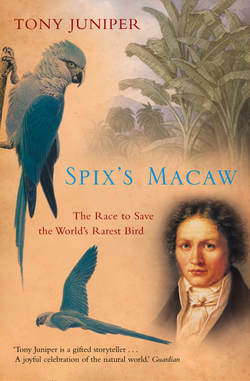Читать книгу Spix’s Macaw: The Race to Save the World’s Rarest Bird - Tony Juniper - Страница 10
4 The Four Blues
ОглавлениеVisitors to the Berlin Zoo in 1900 enjoyed a unique spectacle. The crowds filing past the cages didn’t know it, but they were the only people in history to have seen all four species of the spectacular blue macaw alive together. In addition to the rare Spix’s Macaw, captive Hyacinth, Glaucous and Lear’s Macaws were then held in the Berlin aviaries as well. All had been imported from South America. These highly coveted zoological treasures would never meet again.
Today, the three large and similar-looking blue macaws are included in the biological genus Anodorhynchus, the name coined by Spix. These macaws are larger than the Cyanopsitta macaw first collected by Spix. They also differ from Spix’s in having a proportionately larger bill and curious patches of bare yellow skin at the base of the beak and around the eyes. The function of the bright startling highlights is unknown but could be to aid recognition, some form of adornment that is important for bonding and breeding or a means to reduce their temperature when the birds get too hot.
The large, black, hooked bill of the Anodorhynchus macaws is uniquely adapted for eating the fruits of various palms. The largest nuts eaten by the largest species, the Hyacinth Macaw, are about the size of a golf ball. Even with a big hammer or heavy-duty bench vice, it is impossible for a person to break them open. The macaws are, however, experts. They rotate the nuts in their bill manipulating where necessary with tongue and foot to place the tough objects in exactly the correct positioning for peeling. Once they have removed the tough external skin, the birds make perfect transverse cuts with the heavy square chisel at the cutting edge of the lower half of the bill that enables them to split the nuts in two. Inside is the prize, a nutritious fatty kernel.
As the palm trees evolved tougher and tougher shells to prevent their seeds being eaten, so the big blue macaws advanced a larger bill to crack them. And so it went on: an ecological arms race that produced surely the most impressive of all bird bills. Remarkably, the huge and powerful bill of these macaws is rarely used in anger. Despite having the potential to remove fingers easily, the birds are the gentle giants of the parrot world.
Fieldworkers studying Hyacinth Macaws have described the effect of their work on palm nuts as resembling that of a machine tool or laser rather than that of a bird’s bill. Once opened, the coconut-like flesh of the nut is crushed into a paste that the birds find absolutely irresistible. Hyacinth Macaws are clever when it comes to cracking such tough nuts. One German aviculturist noticed that when his macaws were given Acrocomia nuts brought home from a visit to South America the birds used small pieces of wood to help grip the fruits firmly in their beaks. His macaws would shave a small piece of wood 3–4 millimetres long from their perch, position it inside the upper half of their bill and use it as a wedge to keep the smooth nuts in place for easier opening.
These big blue macaws (the Hyancinth, Lears and Glaucous) can eat other food but their ecological niche is very much dependent on palms. Since they eat so many of the nuts, they need lots of palm trees to keep them going, so they live around types of palms that grow in communal clumps. They need palms that produce the right-sized nuts, and nuts that permit the extraction of the nutritious flesh. These exacting requirements are paramount in determining the distribution of these spectacular birds.
The largest of the 3 big blue macaws, Hyacinth Macaw, is the largest parrot in the world. The intelligence, huge size, striking coloration, dramatic appearance and pure charisma of these parrots make them exceptionally collectable. Their top-heavy appearance – a third of their muscle weight is concentrated in their large head to operate the massive beak – gives them a unique identity.
They have a comical expression, particularly when they’re flying – their features appear overemphasised. In some respects they resemble clowns and to the first-time observer it is as if nature has made some amusing mistake. They are very inquisitive, engaging and usually have quite a laid-back disposition. It is no wonder that ever since they were first seen they have been in demand. Rosemary Low sums up the Hyacinth’s appeal. ‘It is just such a charismatic creature, even if you don’t have the faintest interest in parrots you look at one and it just knocks you out. They are incredible birds, not just their colour but their behaviour, their character – it is extraordinary.’
Although there is undoubtedly more to it, colour plays a big part in the attraction. Blue land animals are rare. There aren’t any blue mammals and very few blue birds. Since earliest times people have placed a great value on blue and gone to great lengths to manufacture the colour. Plants from the genus Isatis (woad) yielded a blue dye called indigo that once held great ceremonial importance. Later on, this plant attained considerable commercial value. Until the advent of synthetic dyes, woad was cultivated in great plantations that were for a time a mainstay in some colonial economies. Indigo was, for example, the main export of El Salvador until coffee took over in the 1870s.
Among the parrots there are only a handful of species that are naturally mainly blue and very few that have completely blue or bluish plumage; the four blue macaws are the most spectacular. The least known of the trio of larger blue macaws is the Glaucous Macaw (Anodorhynchus glaucus).
